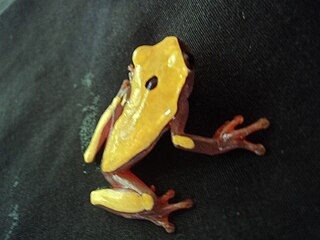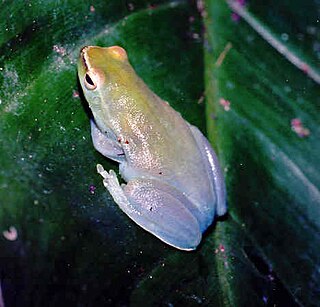
Cope's gray treefrog is a species of treefrog found in the United States and Canada. It is almost indistinguishable from the gray treefrog, and shares much of its geographic range. Both species are variable in color, mottled gray to gray-green, resembling the bark of trees. These are treefrogs of woodland habitats, though they will sometimes travel into more open areas to reach a breeding pond. The only readily noticeable difference between the two species is the mating call — Cope's has a faster-paced and slightly higher-pitched call than D. versicolor. In addition, D. chrysoscelis is reported to be slightly smaller, more arboreal, and more tolerant of dry conditions than D. versicolor.
Dendropsophus aperomeus is a species of frog in the family Hylidae. It is endemic to Peru and occurs on the Amazonian slopes of the Andes in northern and central Peru. Common name Balzapata treefrog has been coined for it.
Dendropsophus berthalutzae is a species of frog in the family Hylidae. It is endemic to southeastern Brazil and occurs in the coastal lowlands and the Serra do Mar in Espírito Santo, Minas Gerais, Rio de Janeiro, São Paulo, and eastern Paraná states. It is named in honor of Bertha Lutz, a Brazilian zoologist and feminist. Common name Bertha's treefrog has been coined for it.

Dendropsophus bogerti is a species of frog in the family Hylidae. It is endemic to the Andes of Colombia and occurs in the Cordillera Central in Antioquia, Caldas, and Chocó Departments. The specific name bogerti honors Charles Mitchill Bogert, an American herpetologist. Soon after its description in 1970, it was relegated to synonymy of Dendropsophus carnifex, but its species status was restored in 1997.

Dendropsophus ebraccatus, also known as the hourglass treefrog, referring to the golden-brown hourglass shape seen surrounded by skin yellow on its back. Their underbellies are yellow. Their arms and lower legs usually display bold patterns while their upper legs or thighs are light yellow giving them the appearance of wearing no pants. The species name "ebraccata" translates to "without trousers" in Latin.
Dendropsophus garagoensis is a species of frog in the family Hylidae. It is endemic to the eastern slope of the Cordillera Oriental in Boyacá Department, Colombia. Common name Garagoa treefrog has been proposed for it.

Dendropsophus leucophyllatus is a species of frog in the family Hylidae. It is found in the Amazon Basin . This widespread and locally common species is found near water in a wide variety of tropical habitats. There are no known significant threats to this species.

Dendropsophus marmoratus is a species of frog in the family Hylidae. It is found in the Amazon rainforest and montane forests in the eastern piedmont, in Bolivia, Brazil, Colombia, Ecuador, French Guiana, Guyana, Peru, Suriname, and Venezuela. Its natural habitats are subtropical or tropical moist lowland forests, intermittent freshwater marshes, and heavily degraded former forest. "Marmoratus" in Latin means "marble," perhaps referring to the dorsal coloring pattern. It is threatened by habitat loss.
Dendropsophus melanargyreus is a species of mid-size tree frog in the family Hylidae. It is found in Bolivia, Brazil, French Guiana, Paraguay, and Suriname. Its natural habitats are subtropical or tropical dry forests, subtropical or tropical moist lowland forests, and intermittent freshwater marshes. It is threatened by habitat loss.
Dendropsophus meridianus is a species of frog in the family Hylidae. It is endemic to southeastern Brazil.

Dendropsophus phlebodes, the San Carlos treefrog or San Carlos dwarf treefrog, is a species of frog in the family Hylidae. It is found in western Colombia, Costa Rica, Nicaragua and Panama. Its natural habitats are tropical moist lowland forests, but it may also occur in disturbed habitats. It is threatened by habitat loss.

Dendropsophus robertmertensi is a species of frog in the family Hylidae. It is found in the Pacific lowlands of El Salvador, Guatemala, and southeastern Mexico. A separate population exists in the Cintalapa Valley in Chiapas.
Dendropsophus stingi is a species of frogs in the family Hylidae. It is endemic to Colombia and occurs on the eastern slope of the Cordillera Oriental in the Boyacá Department. The species was named after celebrity musician Sting in recognition of his "commitment and efforts to save the rain forest". Despite this, common name Kaplan's Garagoa treefrog has been coined for it.
Dendropsophus subocularis is a species of frog in the family Hylidae. It is found in eastern Panama and northwestern Colombia to the Magdalena River Valley. It occurs from the sea level to at least 800 m (2,600 ft), and perhaps as high as 1,650 m (5,410 ft) above sea level.

Dendropsophus triangulum is a species of frog in the family Hylidae. It is found in the upper Amazon Basin in Bolivia, western Brazil, Colombia, Ecuador, and Peru.

Callimedusa tomopterna, the tiger-striped tree frog, is a species of frog in the subfamily Phyllomedusinae. It is found in northern South America in the Upper Amazon Basin of Bolivia, Peru, Ecuador, and Colombia, Amazonian Brazil, and the Guianas from southeastern Venezuela to French Guiana. It might represent more than one species.

Scinax elaeochroa, commonly known as the Sipurio snouted treefrog, or olive snouted treefrog, is a species of frog in the family Hylidae. It is found in the Caribbean lowlands of Nicaragua and Panama and in the Pacific lowlands of Costa Rica and Panama, with an isolated population in Colombia.

Scinax rostratus is a species of frog in the family Hylidae. It is found in central Panama and eastward to Colombia, Venezuela, and coastal lowlands of Guyana, Suriname, and French Guiana. Common name Caracas snouted treefrog has been coined for this species.

Scinax ruber is a species of frog in the family Hylidae which is known in English as the red snouted treefrog or red-snouted treefrog, sometimes also Allen's snouted treefrog, the latter referring to the now-synonymized Scinax alleni. This widespread species is found in much of Amazonian and northern coastal South America and into Panama, as well as in some Caribbean islands as introduced populations. It is a complex containing several cryptic species.

Sphaenorhynchus lacteus, the Orinoco lime treefrog or greater hatchet-faced treefrog, is a species of frog in the family Hylidae. It is a widely distributed species found in the Orinoco and Amazon basins in Venezuela, the Guianas, Colombia, Brazil, Ecuador, Peru, and Bolivia. It also occurs in Trinidad and Tobago.














